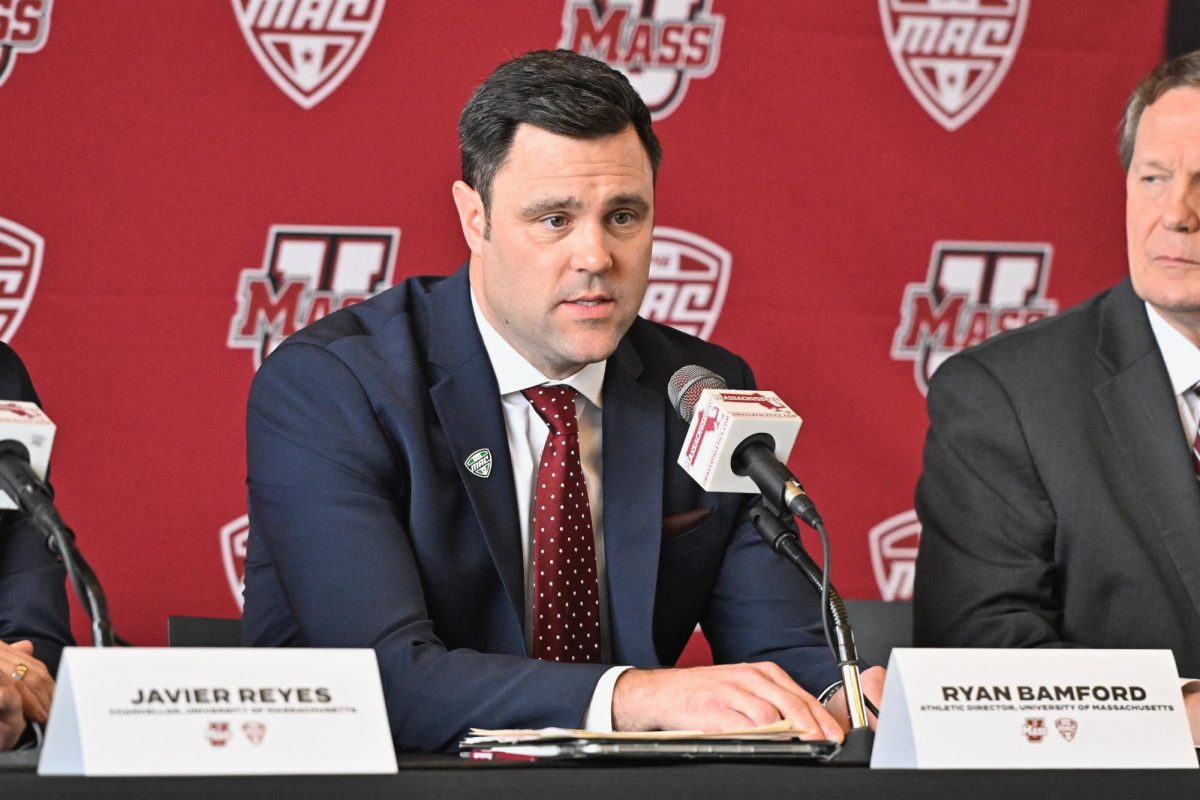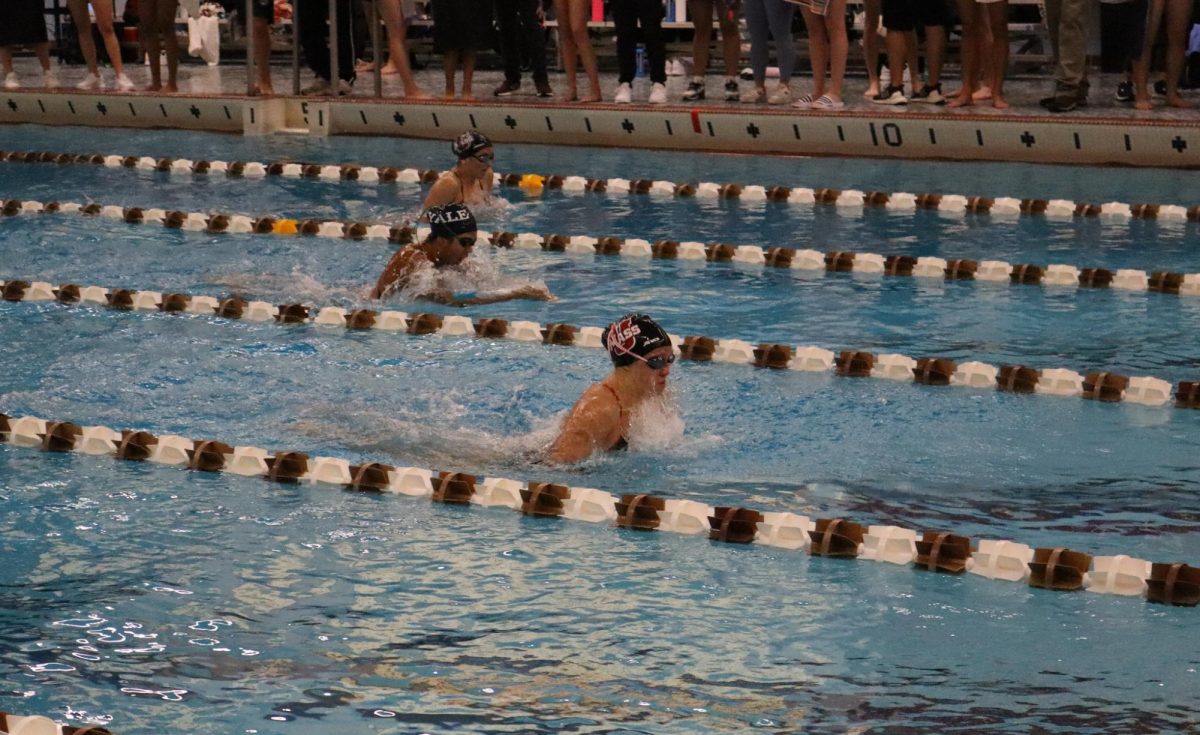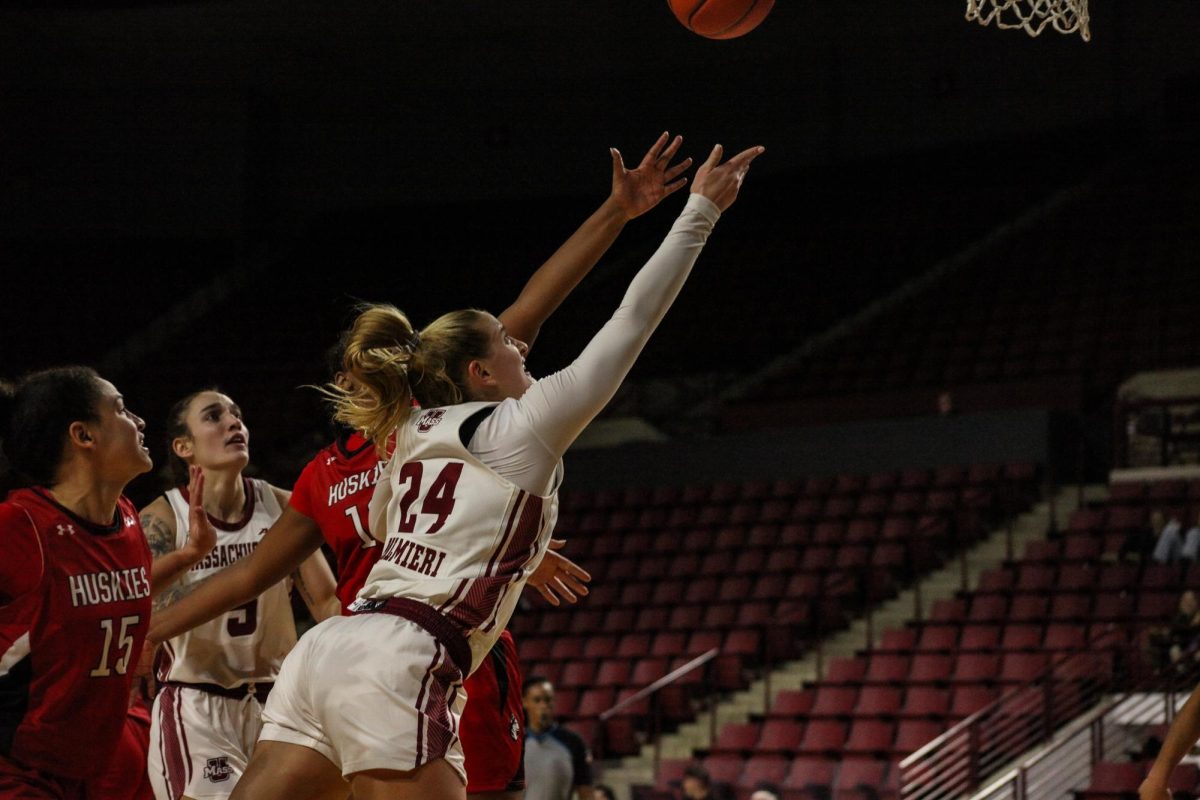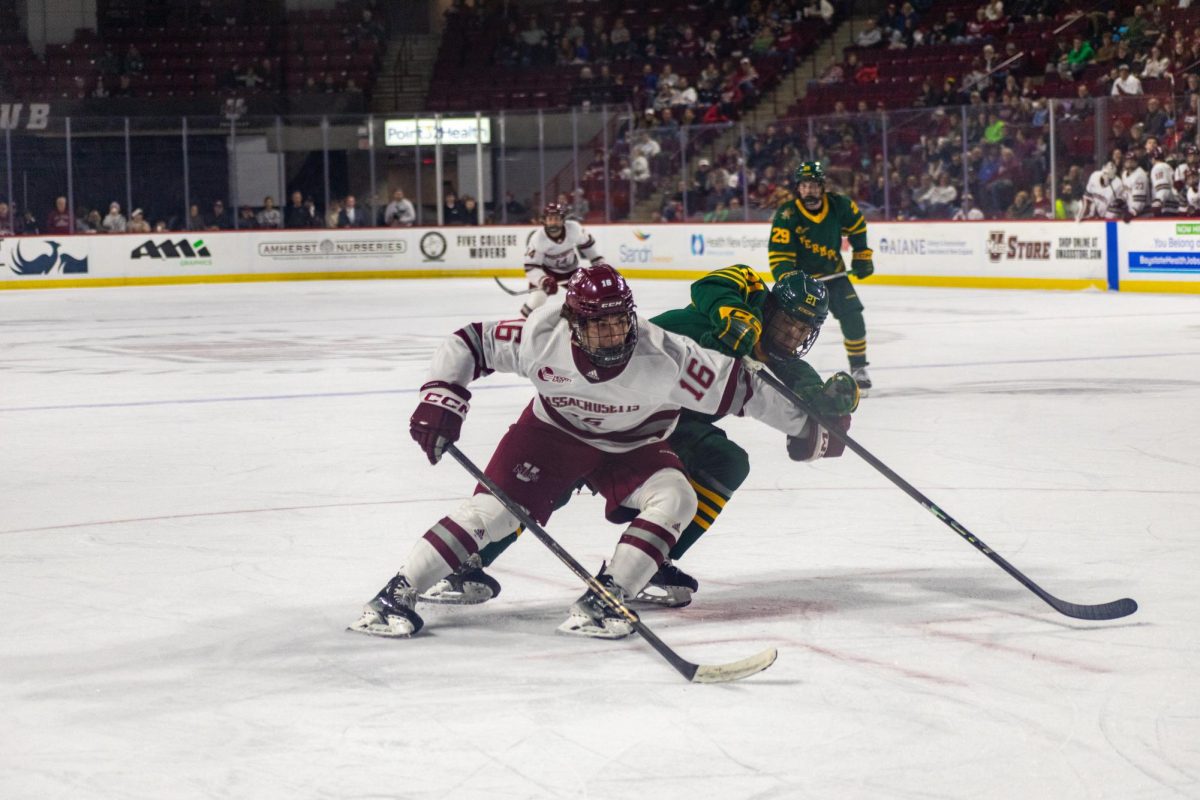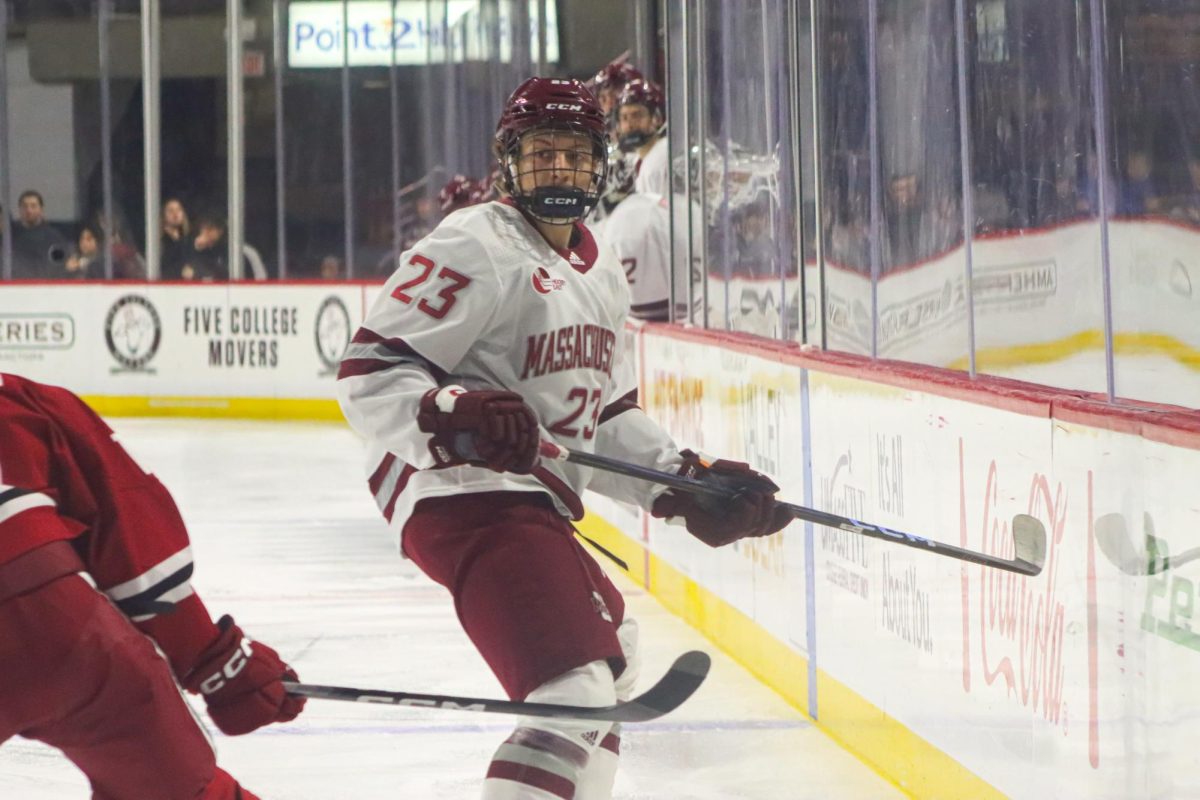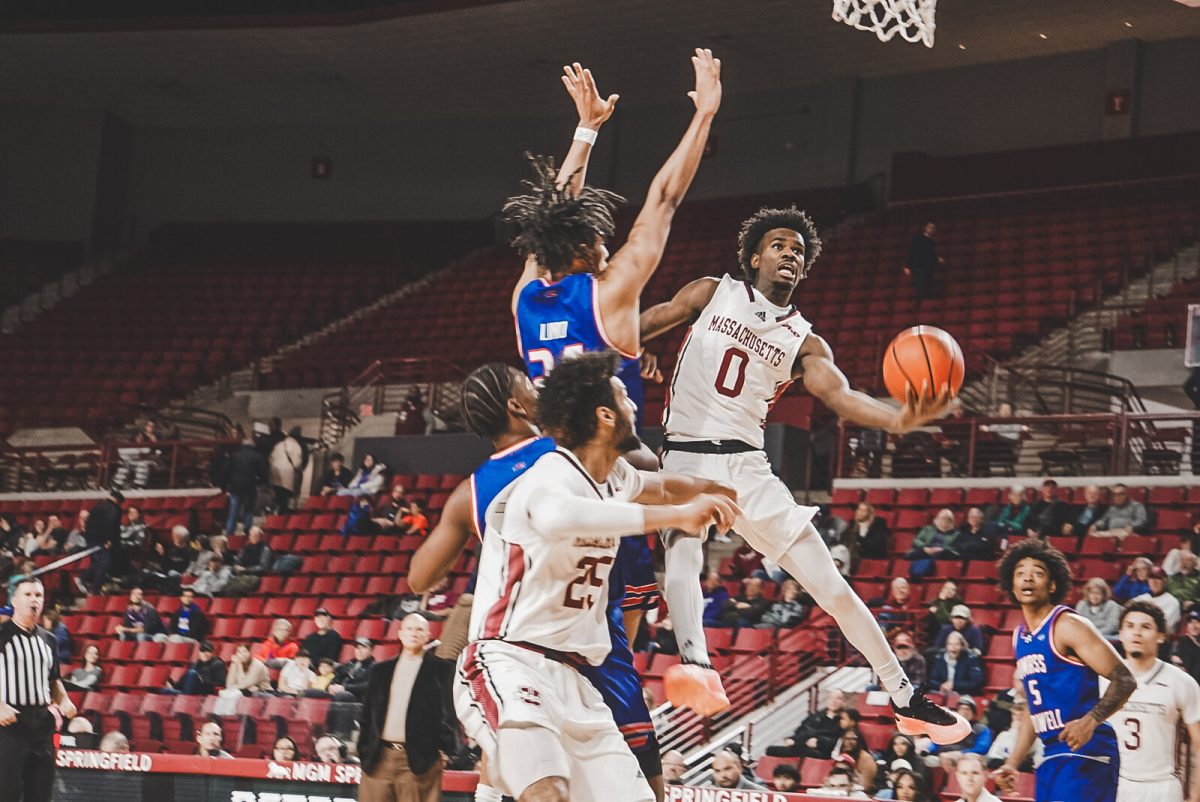With Thursday morning’s introductory press conference at its Football Performance Center, the University of Massachusetts officially presented a new era as a full member of the Mid-American Conference, which the University enters with unapologetic ambition.
Chancellor Javier Reyes, Director of Athletics Ryan Bamford, MAC Commissioner Dr. Jon Steinbrecher, head football coach Don Brown and head basketball coach Frank Martin all gave opening statements and answered questions from the media.
“It is a day of change, a day where we’re going to our next chapter in our athletics programs,” Reyes said. “Of course, joining the MAC, finding a home for our football team, to continue our investments in all our programs … We know that this brings stability to our athletics programs across the board.”
Bamford started by showing gratitude to the Atlantic 10, where UMass grew as a founding member. He explained the move is as much about what the University has done in the past as it is about the future.
“Now more than ever, there is an opportunity for us to really focus on two objectives: to focus on alignment, and to focus on access,” Bamford said. “And to be at a place where we thought we could grow and thrive as an athletics department to meet the next moment, to meet what’s ahead of us, and to think about the next 50 years for UMass athletics.
“It’s time for us to meet that moment and to do so with unapologetic ambition.”
UMass and Bamford’s stated objective is to be the standard of excellence in academics and athletics in the MAC, with Bamford reassuring multiple times that the University will not fall into complacency, instead pushing for growth and being prepared for its entrance into the new conference as a competitive member.
The move perhaps represents a change in stance or mentality: UMass stopped being passive and waiting for the perfect solution to arrive and took ownership of the situation. Bamford didn’t wait for a golden opportunity; he created one.
Commissioner Steinbrecher began by quoting Abraham Lincoln, saying “I will get ready and maybe the chance will come.”
In different ways, this was an opportunity for both the conference and the University. UMass needed a home for its football department, but one that made sense for this type of academic institution.
“The opportunity to add Massachusetts was simply too great to pass up,” Steinbrecher said. “It is rare to be able to add a flagship university that is among the finest institutions in the country.”
Fully comprised of public research universities, the MAC couldn’t pass up the chance to add an academically strong university with the size, funding and history that UMass has. Massachusetts became the MAC’s first new full member in over 25 years, which Steinbrecher said exemplifies how they view UMass: “We don’t open our door to just anyone.”
On the University’s side, it couldn’t pass on the opportunity to join a conference as stable as the MAC to grow its athletic department and football program.
The addition of UMass expands the MAC’s geographic presence while maintaining its homogeneity in location and type of institution. It doesn’t stretch the conference’s geography much due to its proximity with Buffalo (which Bamford described as a possible rivalry), but Steinbrecher said it gives the conference a foothold in the northeast corridor, attractive for media markets in a heavily populated part of the country.
The relationship between Steinbrecher and Bamford goes back over a decade. Conversations picked up last September when Bamford inquired about a move. In November, the commissioner quietly visited UMass’ campus and watched a football game. Then, two weeks ago, the conference’s leadership met and concluded the process by voting unanimously to add Massachusetts as its 13th member.
Football drives the bus in collegiate athletics, and it drove UMass into the MAC. But the speakers made a point to focus on how the move raises the entire athletic department.
UMass has grown tremendously since it left the MAC in 2015 as a football-only member. According to Bamford, when Massachusetts left the MAC, it ranked 12th out of 13 in spending and 12th of 13 in coaching salaries. If UMass was in the MAC now, it’d rank near the top of those categories with Toledo. Bamford says UMass will rank No. 1 in the conference in those areas when it joins the MAC in 2025.
“We weren’t prepared for that moment,” Bamford said of the initial departure from the conference. “We have to be prepared for those moments when we go into the MAC to, quite frankly, go and win and dominate. That’s our goal.”
Brown showed excitement as well, ending his turn at the microphone with a trademark “yeah buddy!” The football coach guided UMass into a promising turnaround last year. The move will help with, among other things, tangible incentives.
“We’ve got a group of guys that have been itching for eight years to compete for a conference title. That’s what you’re looking for your players to achieve,” Brown said.
But for Steinbrecher and the MAC, in a football-powered world of conference realignment, why would there be interest in adding a school with such little success in football at the FBS level?
“I’m looking at a football program that I think has a world of potential,” Steinbrecher said. “And they had no hope of really fully actualizing what the program could be until they could get as a full member in a conference. And so, I like what I’ve seen in the investments that have been made, I like what I see in the leadership of the program … You start looking at [some of the wins] and you say, they got a chance here. I see no reason why, given the level of commitment, this can’t be a very successful football program.”
But while UMass football fans on social media have been mostly ecstatic about the move, there’s a divide between the football and basketball-focused fanbases. In the perspective of many, the University’s move to the MAC compromises the success and history of the men’s basketball program, instead supporting a struggling football team.
Bamford and Martin addressed that view especially through statements of funding and ambition.
“I want to make sure that everything around our basketball program for [Martin] gets elevated,” Bamford said, “because we promised that and I want our fanbase to know, like we’re not going in there … just coast right in and start winning. I want us to build the brand we had in the 90s, we can do that in the MAC.”
“I said this to donors, to basketball supporters, our goal no matter what conference you’re in is to win conference championships and go to the NCAA Tournament. When we’re doing that in the next five years, everybody is going to be energized by that. Look at our crowds last year and look at them this year. Winning is a great marketing tool.”
Martin agreed that a rising tide lifts all boats, citing his experience at Kansas State as an example of a department investing in football and benefiting everywhere else from it.
“Coming from where I’ve been before I came to UMass, I’ve seen what investing in football does for the whole athletic department,” Martin said. “… As long as the school leadership is committed to allowing us to continue to grow, I’m all in.”
“I don’t view this as a basketball coach, I view this as somebody that’s invested in making it better for everybody here. Elevating football is going to make it better for everybody.”
Bamford reminded him of that commitment with a brief story about a meeting between them. In that meeting, which happened during Martin’s hiring process two years ago, Bamford told him they’re taking a big step in their investment in basketball with him coming. Bamford said, “You coming is going to allow us to ramp up our resources for basketball, allow us to build a competitive program that’s going to get back into the top half, top third of the A-10.”
Martin then told him it would take two years to get there, and at two years, they’d evaluate together where they are. Bamford affirmed he’ll do everything he can at that moment to invest even further.
Now is that moment. UMass men’s basketball reached 20 wins in a season within two years under Martin. The checkpoint is here, and the Minutemen are right on track.
“Whether we’re in the A-10 or in the MAC, that investment needs to keep happening for our basketball program to flourish,” Bamford said. “We’re hitting all gas, no brakes.”
When it comes to investment, another question mark of the move to the MAC was travel costs for the athletic department. While the Mid-American is centered around the Midwest, the conference’s compact geographic footprint means trips won’t be much longer than they are in the A-10.
According to Bamford, the cost of traveling will increase slightly because teams will be flying more often, but he sees the five to eight percent increase in cost as an opportunity for expansion with higher revenue from joining the conference.
UMass will already have the highest resourced athletics department in the conference by the time it joins, and Bamford is expecting the budget to grow considerably.
“This [move to the MAC] will allow us to grow our revenues to the department by anywhere from eight to 10 times what we’re currently seeing from a conference standpoint right as we enter the league. I think the ability to grow that over time is really going to be an impactful piece to our growth as a department.”
Bamford committed to increasing the budget for both football and basketball before arrival to the MAC in 2025, not leaving basketball out to dry while football reaps the benefits.
According to Bamford, Massachusetts will likely be spending 500K a year in NIL collectives for men’s basketball to not only recruit, but retain players. UMass will be the most well-resourced team in the league from the get-go.
As for UMass sports that the MAC doesn’t sponsor, Bamford is working to find a home for men’s soccer, men’s lacrosse and women’s rowing.
He believes men’s soccer will have an opportunity to become a MAC sport again when UMass joins the conference in 2025. The league stopped sponsoring it following the 2022 season and doesn’t currently have enough members to reinstate the sport. UMass would be the fifth MAC school with a men’s soccer program, so the conference will have to add an affiliate member to reach the minimum threshold of six members to form a league.
Bamford has discussed it with Steinbrecher and both confirmed Thursday that the process is happening now. Men’s soccer was a strong MAC sport in the past, with multiple teams consistently ranked in the top 25 and making the NCAA Tournament. In any case, the league would look quite different for the Minutemen, with just six teams compared to 14 in A-10.
“[I’m] really excited, you can feel the buzz,” UMass men’s soccer coach Fran O’Leary told the Daily Collegian. “You can just feel the buzz around the whole athletic department and probably around the school … I’m really looking forward to it. I think there’s a little bit of work to be done on the men’s soccer side to put the whole league back together, but really, really excited just as a department. Everybody has a home now and there’s good times ahead for UMass athletics.”
Women’s rowing and men’s lacrosse have formally applied to remain in the Atlantic 10 as an affiliate member. UMass will find out during the summer whether those sports can remain in the A-10, and Bamford thinks men’s lacrosse has a good chance at staying.
Pedro Gray Soares can be reached at [email protected] and followed on X/Twitter @P_GraySoares.

